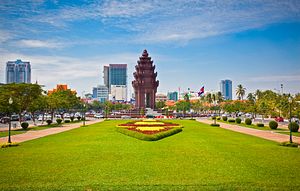Few cities have a more troubled past than Phnom Penh. Once known as the Paris of the East, it was thrown into chaos near the end of the Cambodian civil war, and in 1975 lost its entire population (over 2 million) during one of history’s most atrociously sadistic social experiments. Four years later, Vietnamese troops chased the murderous regime out of Phnom Penh and into isolation, and Cambodia began the seemingly insurmountable task of rebuilding. This included re-populating a ghost city, the once-vibrant capital where only a few foragers and scofflaws remained to survive on what the exodus left behind. Pigs roamed the National Library.
The period during which Phnom Penh embarked on its second birth has been an historic one for Asia. Unprecedented economic growth, global trade, poverty alleviation, and social transformation have reached nearly every corner of the region, from Indonesia to Korea. Vietnam, Cambodia’s Eastern neighbor, reformed itself from a centrally planned straggler into a dynamic middle-income powerhouse. To the West, Thailand did the same. Cambodia seems to have the same advantages as its successful neighbors: a coastline, low labor costs, and a developmental outlook. Indeed, for the past two decades, Cambodia’s annual GDP growth rate has averaged 7.7 percent, the world’s sixth highest. For a country re-starting from almost nothing, such high growth can be expected. However, GDP per capita (2014) is still third lowest among Southeast Asian countries, and in the greater Asian region leads only Nepal and Afghanistan. Education spending as a percentage of GDP (2.6 percent) lags Vietnam (6.3 percent), Thailand (3.8 percent), and Laos (2.8 percent), and infrastructure quality trails its regional peers.
For better or worse, Phnom Penh is a living embodiment of this mixed success. Compared to its rowdy neighbors Bangkok and Ho Chi Minh City, Phnom Penh appears to be a newcomer, and behind schedule. This is understandable, as any city recuperating from such a tragic history would take decades to find its lost self. This extended recovery is evident in the urban infrastructure, a work in (slow) progress. Many suburban roads are unpaved, floods quickly inundate paved streets due to poor drainage, and buildings are functional but often teeter frighteningly on the edge of disrepair. Only in the urban core, the international face of the city, do concerted planning efforts target a walkable and inviting urban environment.
Phnom Penh’s shortcomings notwithstanding, a slow re-emergence can have benefits, principal among them the preservation of cultural authenticity. The city has avoided being carved up by the type of “5-star” commercial and residential development common in Bangkok, Kuala Lumpur, and Manila. The most visible effort – the $170 million Vattanac Capital Tower, now less than 30 percent occupied – represents a wildly speculative venture whose failure hides behind a gleaming glass façade that is absurdly out of context with its surroundings. The empty edifice also reflects a country that is ambitious but not yet ready for global stature; as such, physical and social space is available for the maintenance of more traditional industries and arts.
The preservation of vernacular architecture – whether by intent or lack of development viability – has enabled the city to retain its pre-disaster charm. The locations of historic photos are easy to identify, providing a fascinating if eerie connection to the city’s unforgettable past. Business is conducted in traditional ways, spilling onto the street in a bricolage of hectic but lively commercial activity that is absent from modern shopping malls. “Mixed use” neighborhoods, present here long before becoming trendy among planners, boast ground-level retail and upper-level residences, shortening commute times to a mere walk downstairs. Sidewalks, often inadequate, blend into streets to create an ironically functional space shared by attentive pedestrians and cautious drivers, reminiscent of the British mews. The centerpiece is a riverfront promenade best described as the Las Ramblas of Asia, buzzing with micro-entrepreneurs, strolling retirees, and rambunctious teenagers. All creates a type of genuine reality that evades contrived spaces such as Bangkok’s Siam Square One and Kuala Lumpur’s KLCC.
While Phnom Penh may not have the imposing skylines and sleek infrastructure of its wealthy neighbors, it has a unique identity: a political and economic capital that has eluded the indelible and culturally destructive forces of modern property development. Would Phnom Penh’s leaders prefer to be another Bangkok? They likely would, for obvious economic reasons. Indeed, poverty is a persistent problem in Cambodia and this is no call to ignore that challenge. However, for the time being the city is a rare gem, an opportunity to experience – and learn from – a resurrection of space and time that once created the urban melting pot of a country rich in culture. Siem Reap has architectural ruins frozen in time, but Phnom Penh is a living history open for observation and engagement.
In an era of eagerly interventionist urban policies, this case illustrates that society itself can sometimes be the best planner. Without disrupting the delicate local economic balance and displacing entrenched communities – two disbenefits accompanying modern urban development – a city can find its own way socially and commercially under smart but unobtrusive governance conditions. These include policies to support the growth of small enterprises and to protect the quality of life for all residents. Phnom Penh’s enduring authenticity is the bottled lightning urban planners and designers toil admirably but fruitlessly to create in larger, wealthier cities. Now in its fourth decade of recovery, Cambodia’s bustling capital is a naturally occurring marvel. It is also – to use a word not often associated with the city – lucky to have this advantage.
Kris Hartley is a Visiting Lecturer in Economics at Vietnam National University – Ho Chi Minh City, and a PhD Candidate at the Lee Kuan Yew School of Public Policy, National University of Singapore.

































